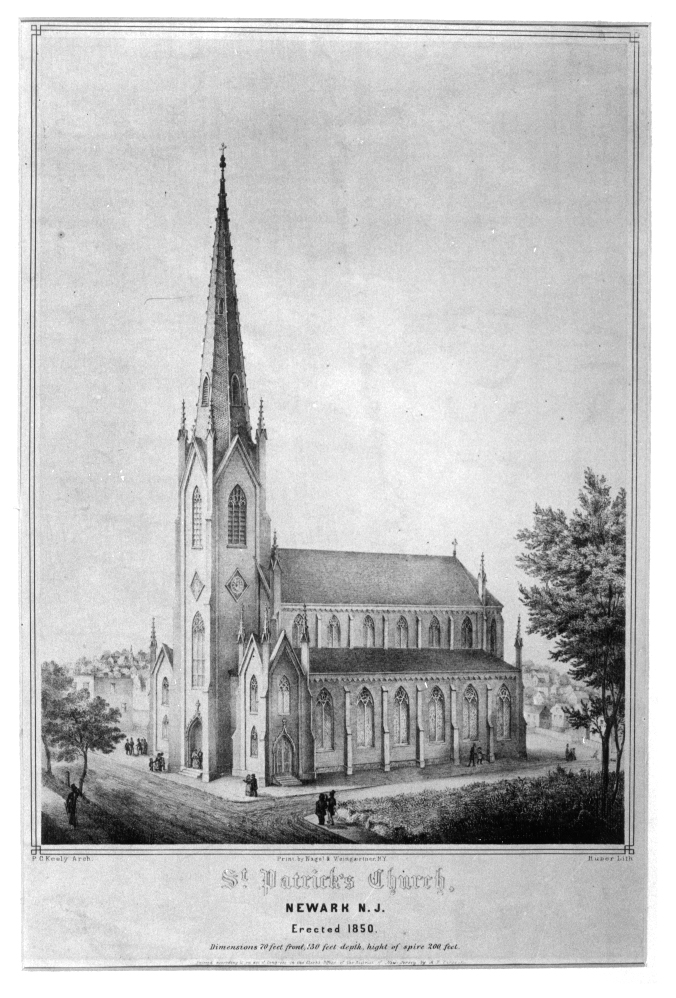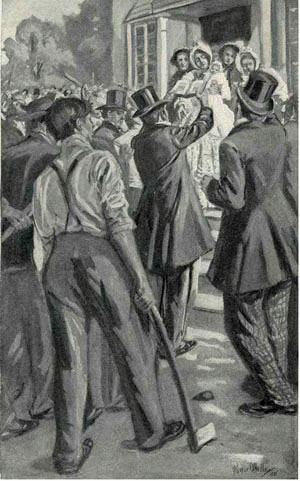My Ancestral Chart
Murphy Family Chart
Murphy Family History
Cemeteries
Causes of Death
Photos
Documents
DNA Testing
Email Me
St. Patrick's Church

In the 1840’s, a blight destroyed the potato crop in Ireland. The resultant famine, the “Great Hunger,” killed over one million persons and drove more than one and a half million Irish to emigrate. Many came to the United States, thousands to New Jersey and to Newark. By the mid-1840’s, there were over 1,500 Catholics in Newark. In 1850 the foreign-born population of New Jersey included over 31,000 Irish, most of them Catholic, and over 10,000 Germans, many Catholics among them. This sudden increase in the Catholic population of Newark strained the facilities of St. John’s Church on Mulberry Street. After proposals to enlarge the church were rejected, Rev. Patrick Moran, pastor of St. John’s, was authorized by Bishop Hughes to build a new church.
Father Moran lived in a Newark that still had large wooded areas watered by brooks and streams. Where St. Patrick’s now stands there was a brook with good fishing. Folks hunted in the hollow along the hill that rises to High Street. Lighting in the homes was provided by candles and kerosene lamps. The streets would not be illuminated until 1852 when gas lighting was installed. Thomas Edison’s invention of the incandescent lamp was thirty years in the future. The horse and wagon were the prevailing mode of transportation in competition with the far from perfected and very expensive steam locomotive. Electric trolleys would not appear until 1888.
Father Moran immediately set to work. He was not discouraged by the poverty of so many of his flock, recently arrived from Ireland. He trusted in their generosity and would not be disappointed. Father Moran chose the corner of Washington and Nesbitt Streets, now Central Avenue, as the site for the new church. The land was part of the estate of Gen. Thomas Ward and was to be sold at public auction on Oct. 26, 1846. Because of prejudice against Catholics, Father Moran feared that, if it were known that the property was wanted as a site for a Catholic church, he would not be able to purchase it. He asked five parishioners to bid separately for the various parcels. They bought most of the land but were outbid on some of the lots by Mr. Norris, a wealthy Protestant, who lived on Washington Place. This situation took an unexpected and happy turn. Father Moran called on Mr. Norris and explained the situation. Norris said that had he known the lots were needed for a new church, he would not have bid on them. He sold the property to Father Moran at cost and also made a generous donation towards the building fund.
According to some accounts, Father Moran himself drew up the plans for the church. However, scholars have noted that the finished St. Patrick’s resembles the Church of Sts. Peter and Paul in the Williamsburg section of Brooklyn, designed by architect Patrick C. Keely and completed in 1848. This has led them to attribute the design to Keely. One scholar has written that “it was through the kind interest of Father Patrick Moran that Mr. Keeley (sic) obtained the Newark work which secured for him the drawing up of a design for St. Patrick’s.” Although Moran had designed extensive alterations to St. John’s, it is difficult to imagine that a plan as complex as St. Patrick’s could have come from anyone other than a professional architect. It seems likely that Keely drew up the plans, incorporating suggestions from Moran.
Moran quickly signed a contract with a builder. Disaster struck the week before the bishop was to come to lay the cornerstone. Late one evening word came to the pastor that the contractor had absconded. Moran was left with bills for lumber, brick, and wages to the workmen. His parishioners raised the money and work on the new church began again. Bishop Hughes laid the cornerstone on Sept. 17, 1848. While Father Moran oversaw the construction, he left all details and fundraising in the hands of his assistant, Rev. Louis Dominic Senez. Father Senez worked tirelessly and the people contributed generously. Finally, the church was completed and Father Senez was named the first pastor.
On March 10, 1850 St. Patrick’s Church was dedicated with elaborate ceremonies by Bishop Hughes. Contemporary newspaper accounts described it as “perhaps, the most ornamental church edifice…and the most striking specimen of the Gothic style in the State.” Its 200-foot high spire, topped with a cross, rose over the entrance to a church 130 feet long, 70 feet wide, with a ceiling 60 feet high. Light filtered through stained glass windows, the most impressive one, that over the altar, depicted “the savior in the attitude of addressing the people.” In an 1852 report, Senez noted that the total cost of the church was “about $25,000,” an enormous sum in those days for a poor parish. Father Senez’s salary as pastor was $50 per month. St. Patrick’s Parish included all of Newark from Belleville to the south end of the city, west to Orange, with the exception of St. Mary’s German parish. It embraced the town of Harrison as well.

A school building was begun early in July 1851, was finished by the contractor late in the fall, and occupied before the winter season of 1851-1852. In it, the parish conducted a Day and Sunday School. An Orphan Asylum for about a dozen children was established in the school dormitory in the winter of 1851-2. Beds were put in the dormitory where the pastor had four rooms fitted up for his own residence. There was ample space for the little family, which increased to 23 in 1852. The orphans were supervised by a few charitable young women who also schooled them. When four of the children were stricken with smallpox in the epidemic of 1852, Father Senez refused to allow any of the teachers to sit up nights. He did the night nursing himself. All the children recovered.
The Irish immigrants whom St. Patrick’s served were not welcomed by many of their fellow citizens. The generous Mr. Norris, who helped Father Moran secure the property, did not represent the majority. The “Know-Nothing” Party, which advocated violence against Catholics and all immigrants, was strong in New Jersey. It was hailed by one Newark newspaper as “a friend of order.” In nearby Elizabethtown, Know-Nothings marched on St. Mary's Catholic Church with the intention of destroying it. The pastor, the Rev. Isaac P. Howell, to avoid bloodshed, sent the men of the parish away and asked the women to come to the church with their children. Mrs. Mary Whelan stood in the doorway, her baby in her arms, and told the leader of the mob that he would have to kill her and her child before he could pass. Humiliated, he turned on his followers and swore he would "brain the first man" who laid a finger on Mrs. Whelan. The mob dispersed.
